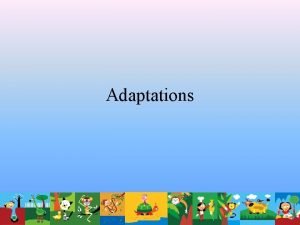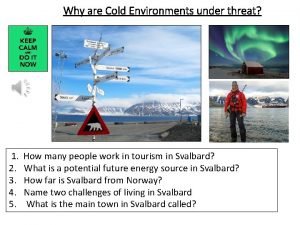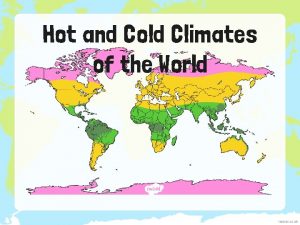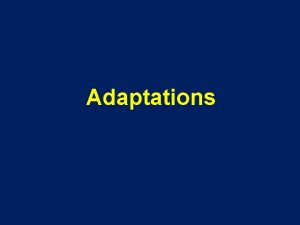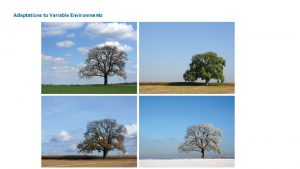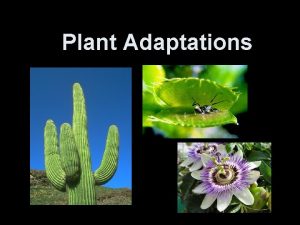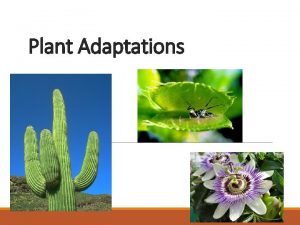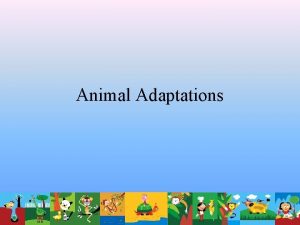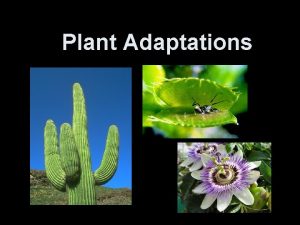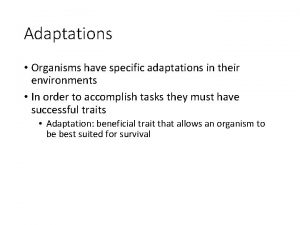Adaptations to survive the cold and hot environments















- Slides: 15

Adaptations to survive the cold and hot environments * ** *** Label some adaptations of animals to live in different environments (G) Recall how having these adaptations help the animal survive in their habitat (F) I can describe how these adaptation allow them to survive (E)

Learning outcomes • Label some adaptations of animals to live in different environments (G) • Recall how having these adaptations help the animal survive in their habitat (F) • I can describe how these adaptation allow them to survive (E) * ** *** Label some adaptations of animals to live in different environments (G) Recall how having these adaptations help the animal survive in their habitat (F) I can describe how these adaptation allow them to survive (E)

Look at the following… What do these animals have in common? * ** *** Label some adaptations of animals to live in different environments (G) Recall how having these adaptations help the animal survive in their habitat (F) I can describe how these adaptation allow them to survive (E)

Animals in Cold Climates Common features: - Thick fur coats - Layer of blubber under the skin - Colour – many change colour in the summer - What about body shape? * ** *** Label some adaptations of animals to live in different environments (G) Recall how having these adaptations help the animal survive in their habitat (F) I can describe how these adaptation allow them to survive (E)

Body Shape - Have fat, round body shapes with short legs - Have small ears – why? * ** *** Label some adaptations of animals to live in different environments (G) Recall how having these adaptations help the animal survive in their habitat (F) I can describe how these adaptation allow them to survive (E)

Look at the following… What do these animals have in common? * ** *** Label some adaptations of animals to live in different environments (G) Recall how having these adaptations help the animal survive in their habitat (F) I can describe how these adaptation allow them to survive (E)

Animals in Dry Climates Common features: - Large thin ears - Little body fat - Thin, silky fur - Long limbs to help spread heat - They also often only come out at night. Why? - What about body shape? * ** *** Label some adaptations of animals to live in different environments (G) Recall how having these adaptations help the animal survive in their habitat (F) I can describe how these adaptation allow them to survive (E)

Body Shape * ** *** Label some adaptations of animals to live in different environments (G) Recall how having these adaptations help the animal survive in their habitat (F) I can describe how these adaptation allow them to survive (E)

Surface Area to Volume Ratio • Animals loose heat from the body surfaces that are in contact with the surrounding air/water. • Reducing this contact surface reduces heat loss • Increasing the surface increases heat loss * ** *** Label some adaptations of animals to live in different environments (G) Recall how having these adaptations help the animal survive in their habitat (F) I can describe how these adaptation allow them to survive (E)

* ** *** Label some adaptations of animals to live in different environments (G) Recall how having these adaptations help the animal survive in their habitat (F) I can describe how these adaptation allow them to survive (E)

Surface Area to Volume Ratio Hidden surfaces are exposed * ** *** Label some adaptations of animals to live in different environments (G) Recall how having these adaptations help the animal survive in their habitat (F) I can describe how these adaptation allow them to survive (E)

Adaptation in animals On your own: • 1. 2. 3. Using these keywords in your answers: adaptation, conserve, surface area : volume ratio, camouflage. An elephant has a small surface area compared to its volume. How will this affect it in hot climates? Why do very small animals struggle to live in the arctic? Why are arctic foxes white in the winter? * ** Label some adaptations of animals to live in different environments (G) Recall how having these adaptations help the animal survive in their habitat (F) Wrinkly elephants? Big eared foxes? *** What’s it all about? I can describe how these adaptation allow them to survive (E)

Compare these two animals… Desert Fox Arctic Fox Can you add any adaptations or reasons for the adaptation? * ** *** Label some adaptations of animals to live in different environments (G) Recall how having these adaptations help the animal survive in their habitat (F) I can describe how these adaptation allow them to survive (E)

* ** *** Label some adaptations of animals to live in different environments (G) Recall how having these adaptations help the animal survive in their habitat (F) I can describe how these adaptation allow them to survive (E)

Take your 4 animals (including at least one with a *) and: • Identify the main/key characteristics of each animal • Name the adaptations that help each animal to survive * elephant * camel * Polar bear mole bat * whale zebra tiger duck flocking starling sheep owl wildebeest dolphin shark Animal What adaptations does the animal have? How adaptations help them survive in that habitat? * ** *** Label some adaptations of animals to live in different environments (G) Recall how having these adaptations help the animal survive in their habitat (F) I can describe how these adaptation allow them to survive (E)
 Exercise in hot and cold environments
Exercise in hot and cold environments How do adaptations help animals survive
How do adaptations help animals survive Economic activity
Economic activity Difference between spread and filling
Difference between spread and filling He prepares all hot and cold dessert.
He prepares all hot and cold dessert. Hot media and cool media
Hot media and cool media Hot and cold world map
Hot and cold world map Hot working and cold working difference
Hot working and cold working difference Hot and cold working process
Hot and cold working process Hot media and cold media
Hot media and cold media Machining operations
Machining operations Pengerjaan panas dan dingin
Pengerjaan panas dan dingin Hot and cold application
Hot and cold application Hot media and cold media
Hot media and cold media 3 sandwiches
3 sandwiches Hot rolling and cold rolling
Hot rolling and cold rolling

